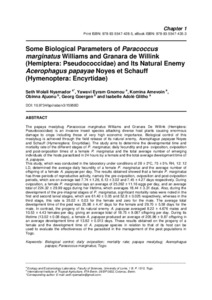| dc.contributor.author | Nyamador, S.W. |
| dc.contributor.author | Gnomou, Y.E. |
| dc.contributor.author | Amevoin, K. |
| dc.contributor.author | Ajuonu, O. |
| dc.contributor.author | Goergen, G. |
| dc.contributor.author | Glitho, I.A. |
| dc.date.accessioned | 2023-01-24T13:14:41Z |
| dc.date.available | 2023-01-24T13:14:41Z |
| dc.date.issued | 2022-06 |
| dc.identifier.citation | Nyamador, S.W., Gnomou, Y.E., Amevoin, K., Ajuonu, O., Goergen, G. & Glitho, I.A. (2022). Some biological parameters of Paracoccus marginatus Williams and Granara de Willink (Hemiptera: Pseudococcidae) and its natural enemy Acerophagus papayae Noyes et Schauff (Hymenoptera: Encyrtidae). In G. Ozcan, Research Aspects in Biological Science Vol. 3. Hooghly, West Bengal, India: B P International (p. 1-12). |
| dc.identifier.isbn | 978-93-5547-428-5 |
| dc.identifier.uri | https://hdl.handle.net/20.500.12478/8021 |
| dc.description.abstract | The papaya mealybug Paracoccus marginatus Williams and Granara De Willink (Hemiptera: Pseudococcidae) is an invasive insect species attacking diverse host plants causing enormous damage to crops including those of very high economic importance. Biological control of this mealybug is achieved through the field release of its natural enemy, Acerophagus papayae Noyes and Schauff (Hymenoptera: Encyrtidae). The study aims to determine the developmental time and mortality rate of the different stages of P. marginatus; daily fecundity and pre- oviposition, oviposition and post-oviposition times of a female P. marginatus and the total average number of emerging individuals of the hosts parasitized in 24 hours by a female and the total average development time of A. papayae. This study, which was conducted in the laboratory under conditions of 28 ± 2°C, 75 ± 5% RH, 12: 12 LD, determined the average daily fecundity of a female P. marginatus and the average number of offspring of a female A. papayae per day. The results obtained showed that a female P. marginatus has three periods of reproductive activity, namely the pre-oviposition, oviposition and post-oviposition periods, which are on average last 7.74 ± 1.26, 6.13 ± 3.02 and 7.45 ± 4.27 days respectively. During oviposition, a female P. marginatus lays an average of 25.262 ± 11.16 eggs per day, and an average total of 224.32 ± 29.99 eggs during her lifetime, which averages 18.44 ± 3.31 days. Also, during the development of the pre-imaginal stages of P. marginatus, significant mortality rates were noted in the first and second larval stages, which are 61.40 ± 0.05 and 52.8 ± 0.025 respectively, whereas in the third stage, this rate is 35.02 ± 0.03 for the female and zero for the male. The average total development time of the pest was 25.98 ± 4.47 days for the female and 29.70 ± 5.58 days for the male. In contrast, the progeny of its natural enemy A. papayae averaged 8.22 ± 4.676 males and 10.53 ± 4.43 females per day, giving an average total of 18.75 ± 9.087 offspring per day. During its lifetime (13.02 ± 0.08 days), a female A. papayae produced an average of 205.96 ± 9.87 offspring in an average development time of 13.82 ± 0.013 days. These results obtained on the progeny of a female and the development time of A. papayae species in relation to that of its host can be used to evaluate the effectiveness of the parasitoid in the management of the pest populations in Togo. |
| dc.format.extent | 1-12 |
| dc.language.iso | en |
| dc.publisher | B P International |
| dc.subject | Biological Control |
| dc.subject | Oviposition |
| dc.subject | Papayas |
| dc.subject | Mealybugs |
| dc.subject | Paracoccus Marginatus |
| dc.subject | Togo |
| dc.title | Some biological parameters of Paracoccus marginatus Williams and Granara de Willink (Hemiptera: Pseudococcidae) and its natural enemy Acerophagus papayae Noyes et Schauff (Hymenoptera: Encyrtidae) |
| dc.type | Book Chapter |
| cg.contributor.affiliation | University of Lome |
| cg.contributor.affiliation | International Institute of Tropical Agriculture |
| cg.coverage.region | Africa |
| cg.coverage.region | West Africa |
| cg.coverage.country | Togo |
| cg.coverage.hub | Headquarters and Western Africa Hub |
| cg.researchtheme | Plant Production and Health |
| cg.identifier.bibtexciteid | NYAMADOR:2022 |
| cg.authorship.types | CGIAR and developing country institute |
| cg.iitasubject | Disease Control |
| cg.iitasubject | Plant Diseases |
| cg.iitasubject | Plant Health |
| cg.iitasubject | Plant Production |
| cg.notes | Published online: 01 Jun 2022 |
| cg.publicationplace | Hooghly, West Bengal, India |
| cg.accessibilitystatus | Open Access |
| cg.reviewstatus | Peer Review |
| cg.usagerightslicense | Creative Commons Attribution 4.0 (CC BY 0.0) |
| cg.targetaudience | Scientists |
| cg.identifier.doi | https://dx.doi.org/10.9734/bpi/rabs/v3/15958d |
| cg.iitaauthor.identifier | Georg Goergen: 0000-0003-4496-0495 |
| cg.futureupdate.required | No |

